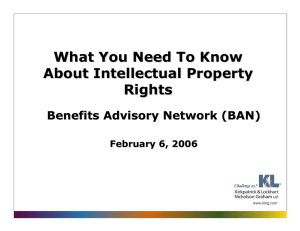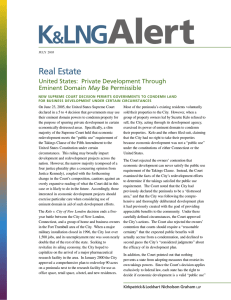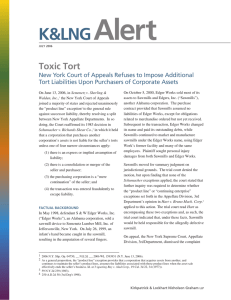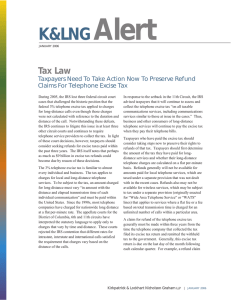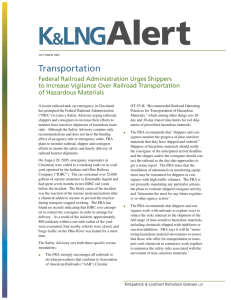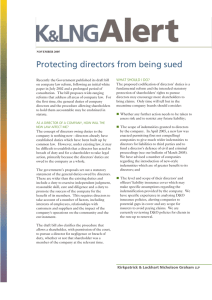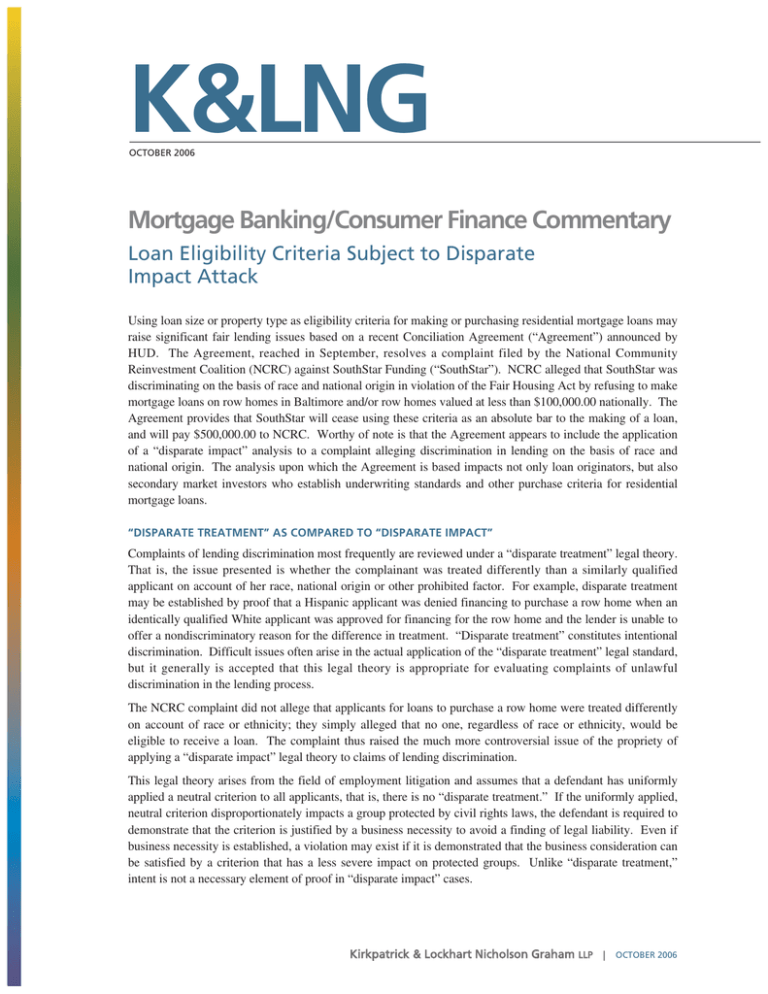
K&LNG
OCTOBER 2006
Mortgage Banking/Consumer Finance Commentary
Loan Eligibility Criteria Subject to Disparate
Impact Attack
Using loan size or property type as eligibility criteria for making or purchasing residential mortgage loans may
raise significant fair lending issues based on a recent Conciliation Agreement (“Agreement”) announced by
HUD. The Agreement, reached in September, resolves a complaint filed by the National Community
Reinvestment Coalition (NCRC) against SouthStar Funding (“SouthStar”). NCRC alleged that SouthStar was
discriminating on the basis of race and national origin in violation of the Fair Housing Act by refusing to make
mortgage loans on row homes in Baltimore and/or row homes valued at less than $100,000.00 nationally. The
Agreement provides that SouthStar will cease using these criteria as an absolute bar to the making of a loan,
and will pay $500,000.00 to NCRC. Worthy of note is that the Agreement appears to include the application
of a “disparate impact” analysis to a complaint alleging discrimination in lending on the basis of race and
national origin. The analysis upon which the Agreement is based impacts not only loan originators, but also
secondary market investors who establish underwriting standards and other purchase criteria for residential
mortgage loans.
“DISPARATE TREATMENT” AS COMPARED TO “DISPARATE IMPACT”
Complaints of lending discrimination most frequently are reviewed under a “disparate treatment” legal theory.
That is, the issue presented is whether the complainant was treated differently than a similarly qualified
applicant on account of her race, national origin or other prohibited factor. For example, disparate treatment
may be established by proof that a Hispanic applicant was denied financing to purchase a row home when an
identically qualified White applicant was approved for financing for the row home and the lender is unable to
offer a nondiscriminatory reason for the difference in treatment. “Disparate treatment” constitutes intentional
discrimination. Difficult issues often arise in the actual application of the “disparate treatment” legal standard,
but it generally is accepted that this legal theory is appropriate for evaluating complaints of unlawful
discrimination in the lending process.
The NCRC complaint did not allege that applicants for loans to purchase a row home were treated differently
on account of race or ethnicity; they simply alleged that no one, regardless of race or ethnicity, would be
eligible to receive a loan. The complaint thus raised the much more controversial issue of the propriety of
applying a “disparate impact” legal theory to claims of lending discrimination.
This legal theory arises from the field of employment litigation and assumes that a defendant has uniformly
applied a neutral criterion to all applicants, that is, there is no “disparate treatment.” If the uniformly applied,
neutral criterion disproportionately impacts a group protected by civil rights laws, the defendant is required to
demonstrate that the criterion is justified by a business necessity to avoid a finding of legal liability. Even if
business necessity is established, a violation may exist if it is demonstrated that the business consideration can
be satisfied by a criterion that has a less severe impact on protected groups. Unlike “disparate treatment,”
intent is not a necessary element of proof in “disparate impact” cases.
Kirkpatrick & Lockhart Nicholson Graham LLP |
OCTOBER 2006
The “disparate impact” theory might be applied in employment litigation, for example, to a fire department
that requires that all firefighters be at least six feet tall. This criterion for employment, although neutral and
uniformly applied, would disproportionately impact females, and, thus, if the employer is unable to
demonstrate that it is necessary to be six feet tall to be an effective firefighter, the employment criterion would
constitute illegal discrimination on the basis of gender.
“DISPARATE IMPACT” AS APPLIED TO CLAIMS OF LENDING DISCRIMINATION
The “disparate impact” legal theory, however, does not easily migrate from employment to lending. Lenders
utilize a host of criteria that have differing impacts on groups protected by the Fair Housing Act and the Equal
Credit Opportunity Act. Down payment requirements, for example, likely have a greater impact on Black and
Hispanic borrowers than White borrowers inasmuch as the racial and ethnic households do not have the same
level of wealth as White households. Perhaps it could be demonstrated that debt ratio standards disqualify a
significantly greater percentage of minority applicants than White applicants. Does such an “impact” require
lenders to demonstrate that the criteria, which are time-honored and customary, are driven by a business
necessity? Would a lender be required to evaluate whether its business reasons for debt ratios could still be
met if the ratios were raised to higher levels and therefore, perhaps, more minorities could be qualified?
These are the types of issues that have greatly concerned the lending industry, and the issues remain largely
unresolved.
To start, the question of whether the “disparate impact” theory is applicable to any claim under the Fair
Housing Act is not free of doubt. The Reagan Administration expressed the view that only intentional
discrimination is prohibited by the Fair Housing Act, even though federal courts of appeal had uniformly held
to the contrary. The Clinton Administration differed and contended that a Fair Housing Act violation could be
established utilizing a “disparate impact” analysis. The view of the current Administration is unclear. The
issue has not yet been addressed by the United States Supreme Court, and the Court may well differ with the
present lower court interpretations if an appropriate case, in which the issue has been preserved, reaches that
level. Unless and until that happens, however, it can be expected that federal courts will continue to apply
“disparate impact” under the Fair Housing Act. It is more certain that a “disparate impact” theory is
appropriate under the Equal Credit Opportunity Act, since the theory is described in the implementing
regulation, Regulation B.
PREVIOUS GUIDANCE FROM FEDERAL AGENCIES
In this backdrop, federal officials—even in Administrations supporting application of “disparate impact”—
have been cautious in describing how it might be applied in the lending context. For example, the “Policy
Statement” of the federal “Interagency Task Force on Fair Lending” that was released during the Clinton
Administration expressed the view that “disparate impact” is applicable to claims of lending discrimination,
“[a]lthough the precise contours of the law on disparate impact as it applies to lending discrimination are
under development.” There have been few, if any, developments since that time.
In apparent recognition of concerns expressed by the lending industry, the Policy Statement says:
Lenders will not have to justify every requirement and practice every time that they
face a compliance examination. The agencies recognize the relevance to credit
decisions of factors related to the adequacy of the borrower’s income to carry the
loan, the likely continuation of that income, the adequacy of collateral to secure the
loan, the borrower’s past performance in paying obligations, the availability of funds
to close, and the existence of adequate reserves. While lenders should think critically
about whether widespread, familiar requirements and practices have an unjustifiable
disparate impact, they should look carefully at requirements that are more stringent
than customary. Lenders should also stay informed of developments in underwriting
and portfolio performance evaluation so that they are well positioned to consider all
options by which their business objectives can be achieved.
2
Kirkpatrick & Lockhart Nicholson Graham
LLP
|
OCTOBER 2006
The agencies offered only two examples of the types of lending practices that might be challenged under the
“disparate impact” theory, one of which is strikingly similar to the issue addressed in the NCRC/SouthStar
Agreement, particularly given the rise in housing prices since the date of the Policy Statement. The Policy
Statement says:
Example: A lender’s policy is not to extend loans for single family residences for
less than $60,000.00. This policy has been in effect for ten years. This minimum
loan amount policy is shown to disproportionately exclude potential minority
applicants from consideration because of their income levels or the value of the
houses in the areas in which they live. The lender will be required to justify the
“business necessity” for the policy.
A lender may contend that the “business necessity” is the need to make a profit; with lender’s fees based on a
percentage of the loan amount, loans below a certain dollar amount simply are not profitable. In response,
the government agency, or private plaintiff, might argue that a lender could charge an additional fee as
necessary to ensure a profit, but the applicant should not be precluded from receiving a loan.
CAN ADDITIONAL “DISPARATE IMPACT” CLAIMS BE EXPECTED?
Inasmuch as the NCRC/SouthStar dispute was resolved by conciliation it is inappropriate to view the
Agreement as a reflection of this Administration’s position on whether a showing of intent is required to
establish a violation of the Fair Housing Act. Staff at HUD have long argued for the application of “disparate
impact” and frequently employ the method of analysis in conducting investigations. The issue rarely rises to
the top, however, primarily because the factual circumstances underlying Fair Housing Act claims almost
always center on “disparate treatment.”
At the same time, if the federal agencies are to pursue a “disparate impact” claim, it most likely will be based
on factual circumstances similar to the above example from the Policy Statement. A minimum loan amount
is a likely target as is a policy of refusing to make loans on a certain type of house, such as a row house. It
appears unlikely that the agencies will challenge, under “disparate impact,” customary and time-honored
underwriting principles, but will look for aberrational criteria that, as the Policy Statement cautioned, “are
more stringent than customary.” The greater the impact on homeownership opportunities in minority
communities, the more likely that the agencies will conclude that the use of “disparate impact” is appropriate.
Although it can be expected that the federal agencies will proceed cautiously in applying “disparate impact”
such caution will not be applied in private litigation. Advocacy groups have strongly argued for an
application of the “disparate impact” test under the Fair Housing Act, and they frequently seek application of
the test even when the facts point toward “disparate treatment.” They have enjoyed some success in the
federal judicial system. Advocacy groups may challenge customary lending criteria that, to this point, have
remained unchallenged, and they most certainly would seek application of the “disparate impact” legal
standard in any such litigation. State attorneys general have also indicated a propensity to employ a
“disparate impact” analysis more readily than federal enforcement officials.
IMPACT ON THE SECONDARY MARKET
NCRC’s challenge was directed only at SouthStar but the remedy provides that SouthStar “will notify . . .
secondary market investors with whom it conducts business that it has discontinued its prohibition against
lending on row homes under $100,000.00 in value and row homes in Baltimore.” The Fair Housing Act
specifically prohibits discrimination in “the making or purchasing” of residential mortgage loans. (Emphasis
added.) Although the instant challenge was not brought pursuant to the Equal Credit Opportunity Act
(“ECOA”), the Federal Trade Commission has interpreted ECOA’s prohibitions on discrimination to reach
“a potential purchaser of the obligation who influences the credit decision by indicating whether or not it will
purchase the obligation if the transaction is consummated.” In 1997, the Department of Justice invoked both
of these statutes in an action against a New York federally chartered thrift institution alleging that the thrift
3
Kirkpatrick & Lockhart Nicholson Graham
LLP
|
OCTOBER 2006
implemented discriminatory loan purchase criteria by excluding certain minority residential areas from
eligibility. To the extent that the secondary market, in establishing the standards that are implemented by the
lenders, requires standards that might have a “disparate impact,” they may find themselves the target of
government agencies or advocacy groups.
PREVENTIVE ACTIONS FOR LENDERS TO CONSIDER
This settlement should not be viewed as the start of an avalanche of new fair lending litigation, but it
demonstrates the importance of a well-rounded compliance program. Fair lending claims, for the most part,
will continue to focus on “disparate treatment” and a compliance program should be so guided. But “disparate
impact” should not be ignored. Aberrational policies should be scrutinized carefully, and it is advisable to
review underwriting engines and pricing policies at least periodically to evaluate the impact on protected
groups and to consider whether the impact can be minimized by alternative criteria that achieve the same
business purpose. Such actions can minimize the risk of legal challenge, even from the most extreme groups.
This Agreement also demonstrates the importance of fair lending considerations to secondary market
purchasers of loans. Since the date of the Policy Statement, the role of the secondary market has continued to
expand and such entities often establish detailed standards regarding loans that are eligible for purchase. Loan
purchasers should have compliance programs that, in many respects, mirror the programs of compliant loan
originators.
If you have any questions about this Alert, please contact Paul F. Hancock (305.539.3378 /
phancock@klng.com) or any member of K&LNG’s Mortgage Banking/Consumer
Finance Group.
4
Kirkpatrick & Lockhart Nicholson Graham
LLP
|
OCTOBER 2006
MORTGAGE BANKING/CONSUMER FINANCE PRACTICE
Kirkpatrick & Lockhart Nicholson Graham LLP has approximately 1,000 lawyers who practice in offices located in Boston, Dallas,
Harrisburg, London, Los Angeles, Miami, Newark, New York, Palo Alto, Pittsburgh, San Francisco, and Washington. K&LNG
represents entrepreneurs, growth and middle market companies, capital markets participants, and leading FORTUNE 100 and
FTSE 100 global corporations, nationally and internationally.
For more information, please visit our website at www.klng.com or contact one of the lawyers listed below.
ATTORNEYS
Laurence E. Platt
Phillip L. Schulman
Costas A. Avrakotos
Melanie Hibbs Brody
Steven M. Kaplan
Jonathan Jaffe
H. John Steele
R. Bruce Allensworth
Irene C. Freidel
Nanci L. Weissgold
Paul F. Hancock
Phillip John Kardis II
Stephen E. Moore
Stanley V. Ragalevsky
David L. Beam
Emily J. Booth
Krista Cooley
Eric J. Edwardson
Suzanne F. Garwood
David Keith Gaston
Anthony C. Green
Laura A. Johnson
Kris D. Kully
Drew A. Malakoff
David G. McDonough, Jr.
Erin Murphy
202.778.9034
202.778.9027
202.778.9075
202.778.9203
202.778.9204
415.249.1023
202.778.9489
617.261.3119
617.951.9154
202.778.9314
305.539.3378
202.778.9401
617.951.9191
617.951.9203
202.778.9026
202.778.9112
202.778.9257
202.778.9387
202.778.9892
202.778.9061
202.778.9893
202.778.9249
202.778.9301
202.778.9086
202.778.9207
415.249.1038
lplatt@klng.com
pschulman@klng.com
cavrakotos@klng.com
mbrody@klng.com
skaplan@klng.com
jjaffe@klng.com
jsteele@klng.com
ballensworth@klng.com
ifreidel@klng.com
nweissgold@klng.com
phancock@klng.com
pkardis@klng.com
smoore@klng.com
sragalevsky@klng.com
dbeam@klng.com
ebooth@klng.com
kcooley@klng.com
eedwardson@klng.com
sgarwood@klng.com
dgaston@klng.com
agreen@klng.com
laura.johnson@klng.com
kkully@klng.com
dmalakoff@klng.com
dmcdonough@klng.com
emurphy@klng.com
Lorna M. Neill
Stephanie C. Robinson
Kerri M. Smith
Holly M. Spencer
Erin E. Troy
Staci P. Newman
Elwood F. Collins
Steve H. Epstein
Nadya N. Fitisenko
Brian M. Forbes
Thomas J. Poletti
Thomas C. Russler
202.778.9216
202.778.9856
202.778.9445
202.778.9853
202.778.9384
202.778.9452
212.536.4005
212.536.4830
617.261.3173
617.261.3152
310.552.5045
212.536.4068
lneill@klng.com
srobinson@klng.com
ksmith@klng.com
hspencer@klng.com
etroy@klng.com
snewman@klng.com
ecollins@klng.com
sepstein@klng.com
nfitsenko@klng.com
bforbes@klng.com
tpoletti@klng.com
trussler@klng.com
DIRECTOR OF LICENSING
Stacey L. Riggin
202.778.9202 sriggin@klng.com
REGULATORY COMPLIANCE ANALYSTS
Dana L. Lopez
202.778.9383 dlopez@klng.com
Nancy J. Butler
202.778.9374 nbutler@klng.com
Marguerite T. Frampton 202.778.9253 mframpton@klng.com
Jeffrey Prost
202.778.9364 jprost@klng.com
Allison A. Rosenthal
202.778.9894 arosenthal@klng.com
Brenda R. Kittrell
202.778.9049 bkittrell@klng.com
Joann Kim
202.778.9421 jkim@klng.com
Teresa Diaz
202.778.9852 tdiaz@klng.com
Robin L. Dinneen
202.778.9481 rdinneen@klng.com
www.klng.com
BOSTON • DALLAS • HARRISBURG • LONDON • LOS ANGELES • MIAMI • NEWARK • NEW YORK • PALO ALTO • PITTSBURGH • SAN FRANCISCO • WASHINGTON
Kirkpatrick & Lockhart Nicholson Graham (K&LNG) has approximately 1,000 lawyers and represents entrepreneurs, growth and middle market companies, capital
markets participants, and leading FORTUNE 100 and FTSE 100 global corporations nationally and internationally.
K&LNG is a combination of two limited liability partnerships, each named Kirkpatrick & Lockhart Nicholson Graham LLP, one qualified in Delaware, U.S.A. and
practicing from offices in Boston, Dallas, Harrisburg, Los Angeles, Miami, Newark, New York, Palo Alto, Pittsburgh, San Francisco and Washington and one
incorporated in England practicing from the London office.
This publication/newsletter is for informational purposes and does not contain or convey legal advice. The information herein should not be used or relied upon in
regard to any particular facts or circumstances without first consulting a lawyer.
Data Protection Act 1988—We may contact you from time to time with information on Kirkpatrick & Lockhart Nicholson Graham LLP seminars and with our regular
newsletters, which may be of interest to you. We will not provide your details to any third parties. Please e-mail london@klng.com if you would prefer not to
receive this information.
© 2006 KIRKPATRICK & LOCKHART NICHOLSON GRAHAM LLP. ALL RIGHTS RESERVED.

